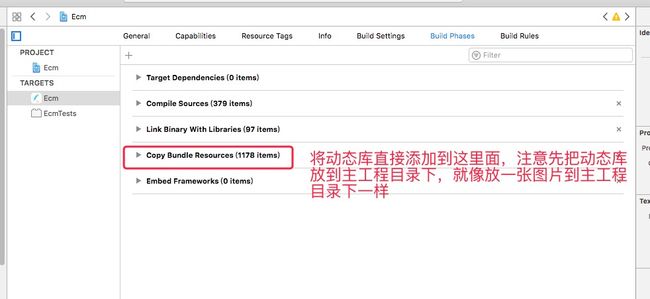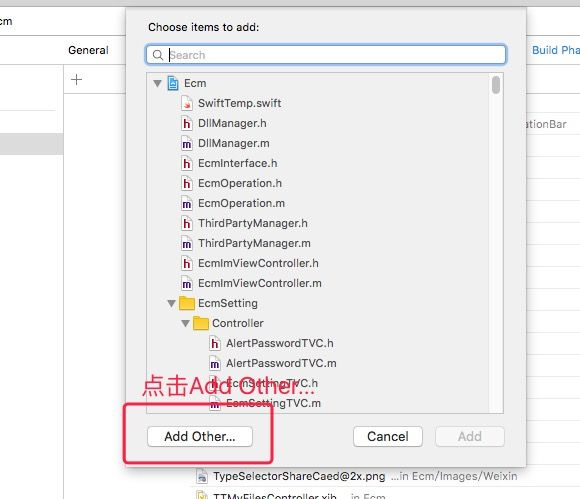写在前面:对于开发企业级应用的开发者而已,以资源文件的形式来加载动态库就显得尤为重要,因为,给不同的客户打不同的IPA包,里面的有些功能是不一样,比如说有一个动态库是专门为一个客户制定的,那么在给其他客户打包时就不应该把这个动态库打进去。所以,为了解决这个问题,我们可以使用下面的这种加载方式。
1.添加动态库到资源
然后,选择你刚才放在主工程目录下的动态库。这时项目目录下多了一个动态库。倘若你之前直接拖进来时目录下就已经存在,请先右键删除引用。
2.动态加载动态库
直接上我项目中实际使用的代码:
这个动态库主要实现的是一个视频会议的功能
这个TBConfMeetingApi类是我处理这个创建会议和加入会议的一个工具类
.h文件
//
// TBConfMeetingApi.h
// Ecm
//
// Created by zengchunjun on 16/9/13.
//
//
#import
#import "TBConfMeetingManager.h"
@interface TBConfMeetingApi : NSObject
+ (void)joinConfWithSiteName:(NSString*)siteName DisplayName:(NSString*)displayName andUserName:(NSString*)userName MeetingID:(NSString*)meetingID MeetingPwd:(NSString*)meetingPwd WithPortrait:(NSString*) portrait VC:(UIViewController*)vc shareCallBack:(TBConferenceShareCallback)shareCallBack;
+ (void)createConfWithSiteName:(NSString*)siteName DisplayName:(NSString *)displayName andUserName:(NSString*)userName HostPwd:(NSString*)hostPwd MeetingTopic:(NSString*)meetingTopic MeetingPwd:(NSString *)meetingPwd WithAutoAdjustVideoBitrate:(BOOL)autoAdjustVideoBitrate VC:(UIViewController *)vc createCallBack:(TBConferenceEnterCallback)createCallBack shareCallBack:(TBConferenceShareCallback)shareCallBack;
@end
.m文件
//
// TBConfMeetingApi.m
// Ecm
//
// Created by zengchunjun on 16/9/13.
//
//
#import "TBConfMeetingApi.h"
@implementation TBConfMeetingApi
// 初始化动态库,也就是加载动态库
+ (BOOL)initFramework
{
if ([[UIDevice currentDevice].systemVersion floatValue] < 8.0)
{
NSLog(@"%s",__func__);
return NO;
}
// 使用GCD一次性代码来只加载一次动态库
static dispatch_once_t priOnceToken;
dispatch_once(&priOnceToken, ^
{
NSString *path = [[[NSBundle mainBundle] bundlePath] stringByAppendingPathComponent:@"TBConfMeeting.framework"];
NSError *err = nil;
NSBundle *bundle = [NSBundle bundleWithPath:path];
if ([bundle loadAndReturnError:&err])
{
NSLog(@"bundle load framework success.");
}
else
{
NSLog(@"bundle load framework err:%@", err);
}
});
return YES;
}
+ (void)createConfWithSiteName:(NSString*)siteName DisplayName:(NSString *)displayName andUserName:(NSString*)userName HostPwd:(NSString*)hostPwd MeetingTopic:(NSString*)meetingTopic MeetingPwd:(NSString *)meetingPwd WithAutoAdjustVideoBitrate:(BOOL)autoAdjustVideoBitrate VC:(UIViewController *)vc createCallBack:(TBConferenceEnterCallback)createCallBack shareCallBack:(TBConferenceShareCallback)shareCallBack
{
//#if !TARGET_IPHONE_SIMULATOR
// [[ConfWithVc shareInstance] createConfWithSiteName:siteName DisplayName:displayName andUserName:userName HostPwd:hostPwd MeetingTopic:meetingTopic MeetingPwd:meetingPwd WithAutoAdjustVideoBitrate:autoAdjustVideoBitrate VC:vc createCallBack:callBack];
//#endif
if (![self initFramework]) {
return ;
}
NSString *className = @"TBConfMeetingManager";
NSString *methodName = @"createConfWithSiteName:DisplayName:andUserName:HostPwd:MeetingTopic:MeetingPwd:WithAutoAdjustVideoBitrate:VC:createCallBack:shareCallBack:";
Class class = NSClassFromString(className);
NSMethodSignature *sig = [[class class] methodSignatureForSelector:NSSelectorFromString(methodName)];
if (sig)
{
NSInvocation *invocation = [NSInvocation invocationWithMethodSignature:sig];
if (invocation)
{
[invocation setTarget:class];
[invocation setSelector:NSSelectorFromString(methodName)];
[invocation setArgument:&siteName atIndex:2];
[invocation setArgument:&displayName atIndex:3];
[invocation setArgument:&userName atIndex:4];
[invocation setArgument:&hostPwd atIndex:5];
[invocation setArgument:&meetingTopic atIndex:6];
[invocation setArgument:&meetingPwd atIndex:7];
[invocation setArgument:&autoAdjustVideoBitrate atIndex:8];
[invocation setArgument:&vc atIndex:9];
[invocation setArgument:&createCallBack atIndex:10];
[invocation setArgument:&shareCallBack atIndex:11];
[invocation invoke];
const char *returnType = sig.methodReturnType;
int *result;
if(!strcmp(returnType, @encode(int)))
{
[invocation getReturnValue:&result];
}
// return result;
}
}
}
+ (void)joinConfWithSiteName:(NSString*)siteName DisplayName:(NSString*)displayName andUserName:(NSString*)userName MeetingID:(NSString*)meetingID MeetingPwd:(NSString*)meetingPwd WithPortrait:(NSString*) portrait VC:(UIViewController*)vc shareCallBack:(TBConferenceShareCallback)shareCallBack
{
//#if !TARGET_IPHONE_SIMULATOR
// [[ConfWithVc shareInstance] joinConfWithSiteName:siteName DisplayName:displayName andUserName:userName MeetingID:meetingID MeetingPwd:meetingPwd WithPortrait:nil VC:vc];
//#endif
if (![self initFramework]) {
return;
}
NSString *className = @"TBConfMeetingManager";
NSString *methodName = @"joinConfWithSiteName:DisplayName:andUserName:MeetingID:MeetingPwd:WithPortrait:VC:shareCallBack:";
Class class = NSClassFromString(className);
NSMethodSignature *sig = [[class class] methodSignatureForSelector:NSSelectorFromString(methodName)];
if (sig)
{
NSInvocation *invocation = [NSInvocation invocationWithMethodSignature:sig];
if (invocation)
{
[invocation setTarget:class];
[invocation setSelector:NSSelectorFromString(methodName)];
[invocation setArgument:&siteName atIndex:2];
[invocation setArgument:&displayName atIndex:3];
[invocation setArgument:&userName atIndex:4];
[invocation setArgument:&meetingID atIndex:5];
[invocation setArgument:&meetingPwd atIndex:6];
[invocation setArgument:&portrait atIndex:7];
[invocation setArgument:&vc atIndex:8];
[invocation setArgument:&shareCallBack atIndex:9];
[invocation invoke];
}
}
}
@end

